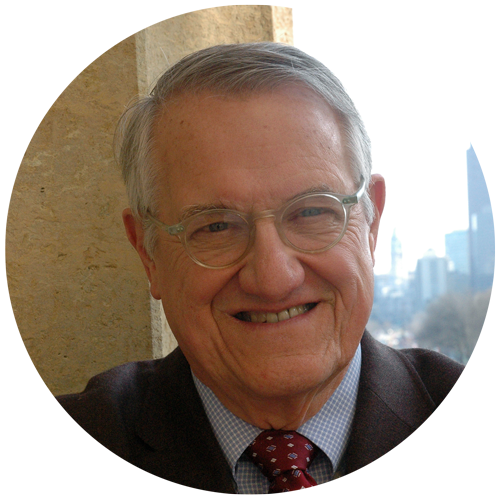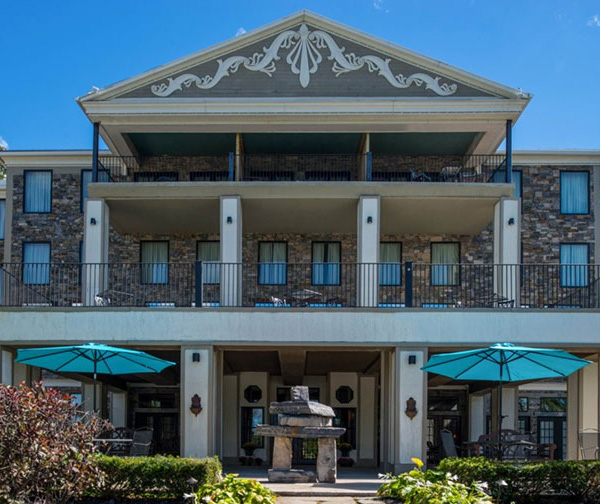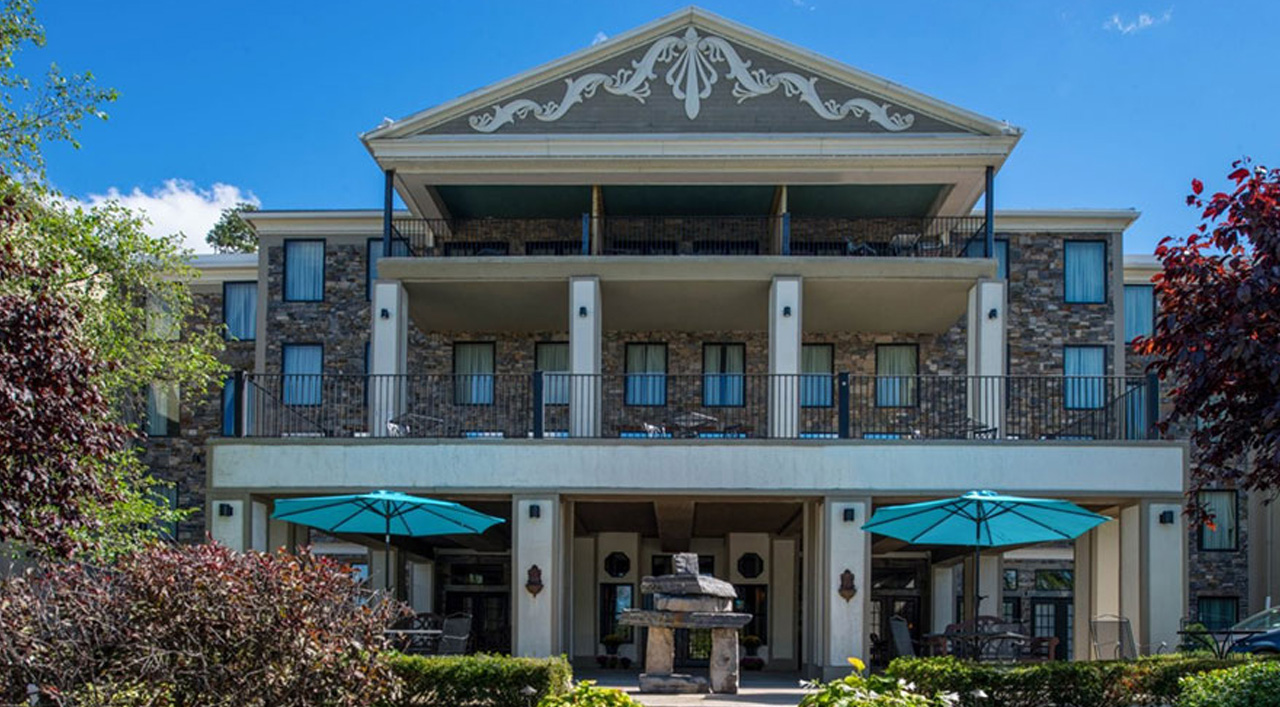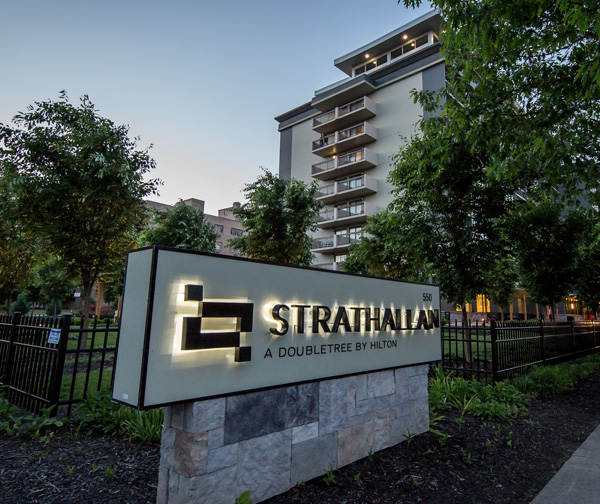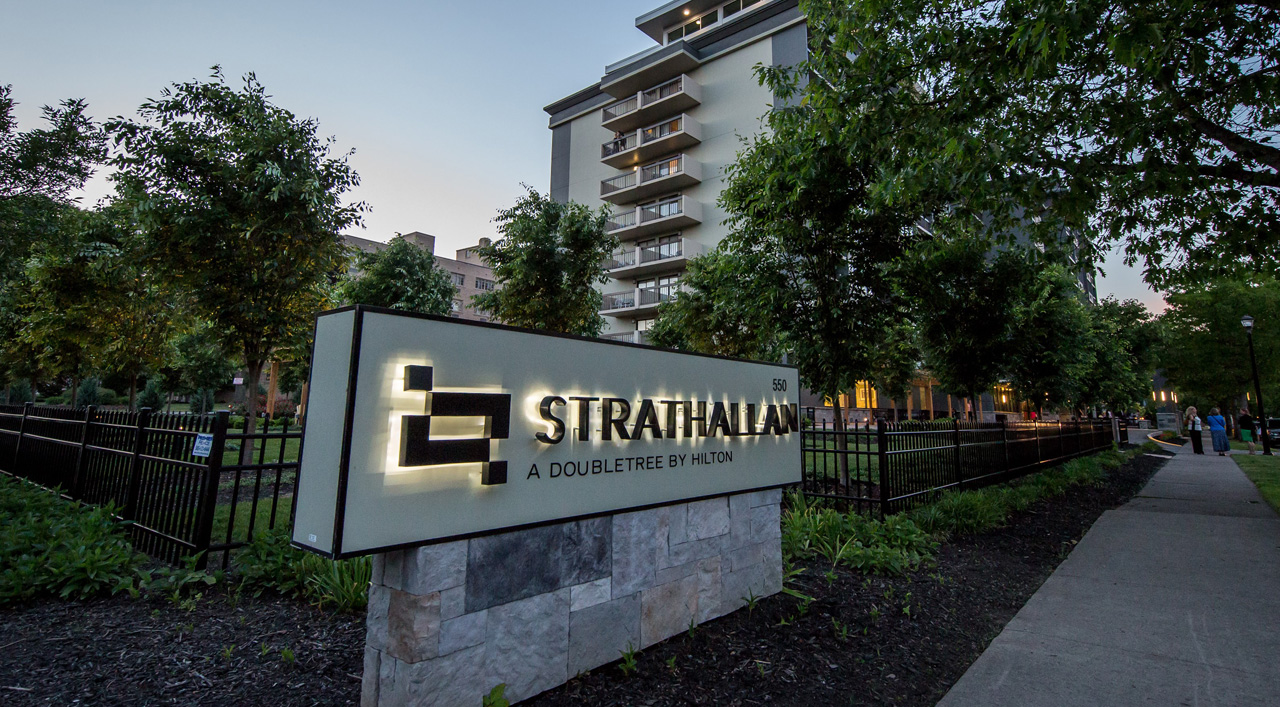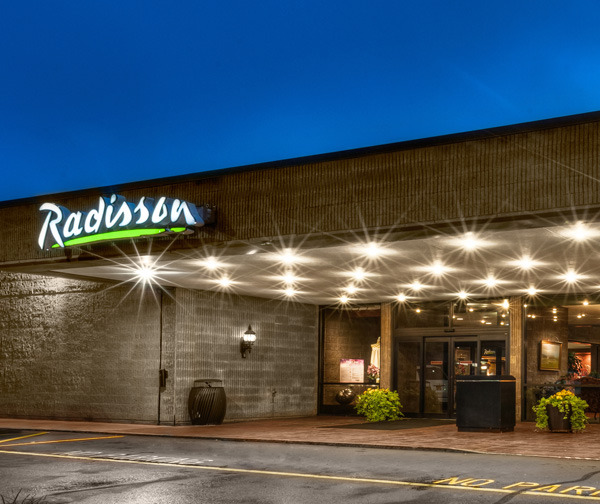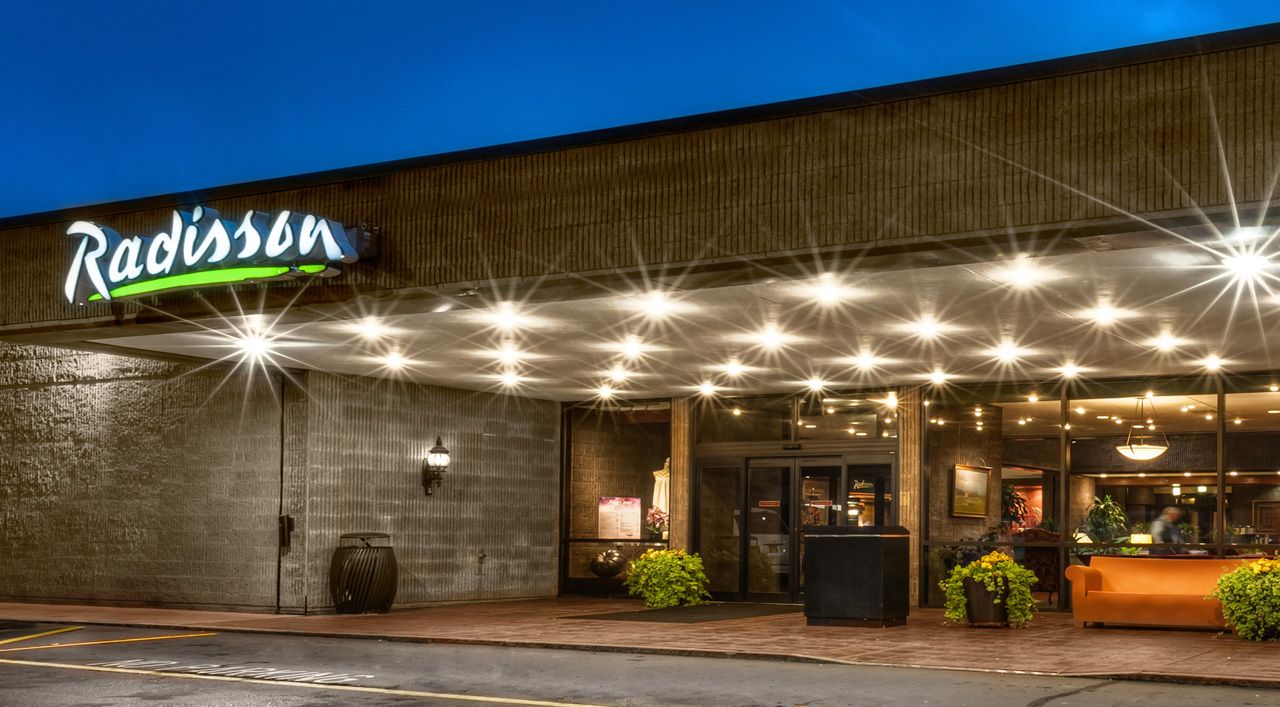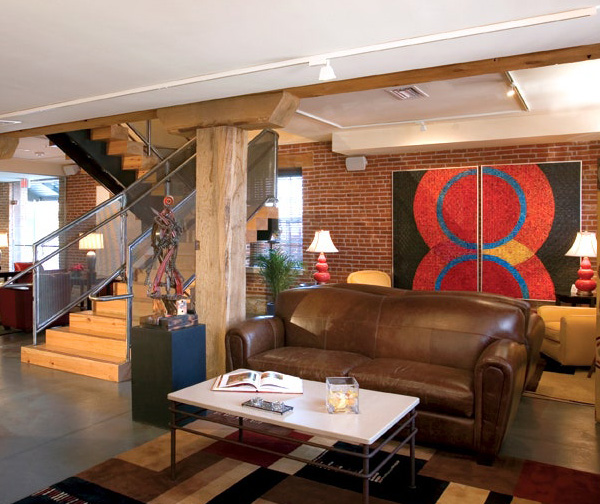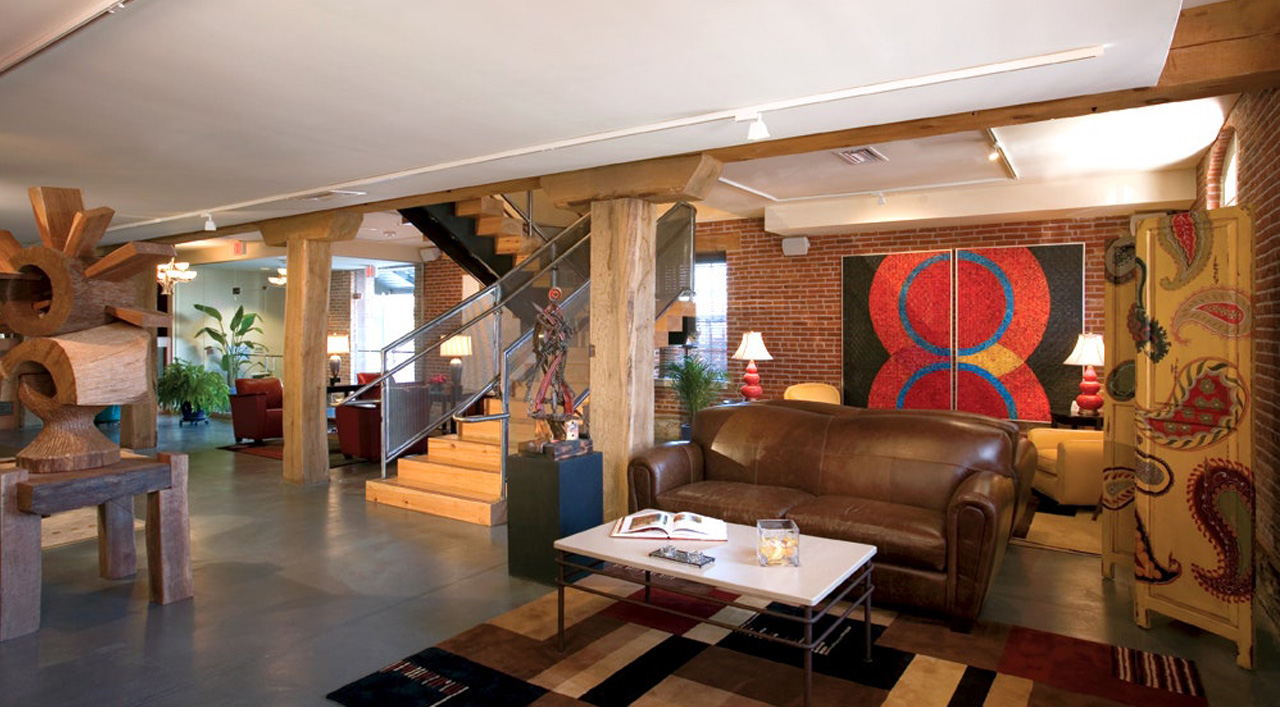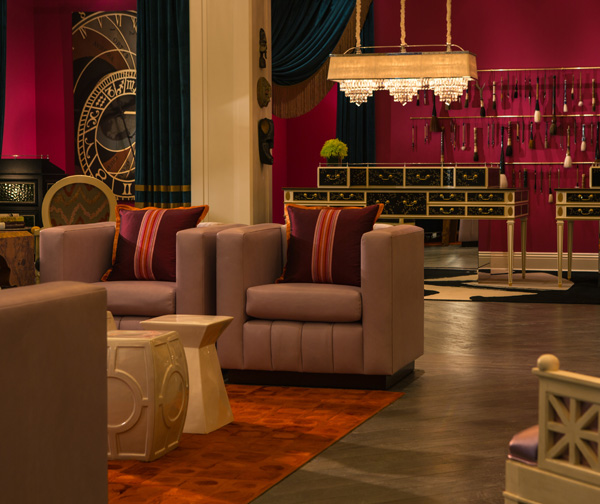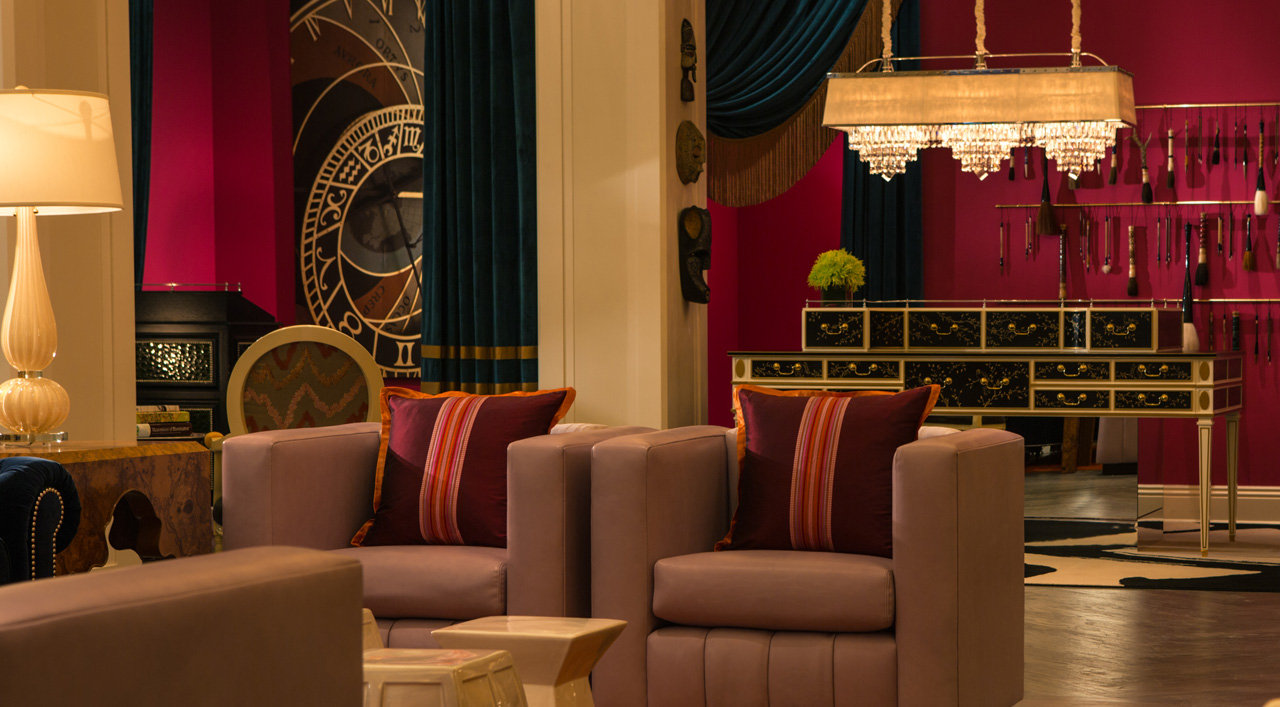Thursday, July 6
Tour participants will arrive in Buffalo or Niagara Falls by air or Niagara
Falls by train and transfer to the elegant and picturesque Niagara Crossing Hotel in Lewiston, NY.
After we are settled into our historic lodgings, we will share an opening dinner with all
participants—including dignitaries and friends from the Tuscarora Nation.
Day 1
- Meet in Lewiston, NY at Niagara Crossing Hotel & Spa
- Check-in at hotel by 4 PM
- Welcome Dinner
- Overnight at Niagara Crossing Hotel & Spa
Friday, July 7
The town of Lewiston is mainly located high on a hill overlooking the
Niagara River at a critical location atop the geological formation known as the Niagara escarpment
that stretches from Wisconsin to the southern shore of Lake Ontario. This artifact of the last Ice
Age literally created the need for Niagara Falls as a way of emptying Lake Erie into Lake Ontario.
It also created a narrow river that now separates the United States and Canada. This thin waterway
enabled the United States to easily attack Canada and for British troops to invade the United States
during the War of 1812. It also provided an easy passage for fugitive slaves to escape to freedom in
Canada prior to the American Civil War. This role of the river will be easily evident to us when we
check out the dramatic Freedom Crossing Monument at the water’s edge in front of our hotel. We’ll
then take a brief walking tour of historic Lewiston and get the town’s full story at the Lewiston
Museum—including the story of how Tuscarora warriors saved Lewiston when British troops attacked on
the morning of 19 December 1813 on their way to Fort Niagara.
From the Lewiston Museum, our Tuscarora history teacher, Vince Schiffert will take us on a bus tour
to the nearby Lewiston Artpark, location of a portage landing used by Tuscarora to bypass Niagara
Falls. We’ll then head in the direction of the Tuscarora Reservation while Vince narrates the story
of the 1813 British invasion pointing out milestones and monuments of the 1813 British invasion. We
will continue this excursion with a tour of the metes and bounds of the Reservation concluding at
the dramatically designed Tuscarora Nation House. A gathering center and show place for Tuscarora,
we’ll take a break at this poignant landmark to learn more from Tuscarora leaders about traditional
democratic practices of Iroquois peoples—especially the Tuscarora—that were so revered by Benjamin
Franklin.
From the Nation House we will proceed to the grounds of the festive annual
Tuscarora Picnic. This event is not in the nature of a Pow-wow. It is rather a homecoming gathering
for Tuscarora and their guests complete with the food, festivities, beauty contests, crafts, and
games to go with it. It’s a moveable feast where you can get food and desserts and move from one
picnic table to another meeting chiefs, clan mothers, and excited children thrilling at the glitter
and fun. The evening is concluded with an unofficial “fireball” competition among fledgling boys and
men that can only be believed by witnessing this colorful after-dark contest. After much laughter
and pleasantry, we’ll retire for the night at the Niagara Crossing Hotel & Spa.
Day 2
- Full Breakfast
- Guided Walking Tour of Lewiston and Waterfront
- Visit and private tour of Lewiston Historical Museum
- Motorcoach tour of Tuscarora sites with Vince Schiffert
- Lunch at Tuscarora Nation House with Tuscarora History Group members and leaders
- Return to hotel for free time to explore on own, shop, or relax
- Motorcoach to Tuscarora Reservation for annual picnic (dinner on own at picnic)
- Shuttle service back to hotel at designated times
- Overnight at Niagara Crossing Hotel & Spa
Saturday, July 8
We’ll begin our day at the new Niagara Amtrak Station for a tour of the
informative Underground Railroad Museum contained within this stunning station. From here we will
ride over to the visitor center and walk around the American portions of Niagara Falls. It’s always
an impressive sight no matter how many times you’ve seen this most visited natural wonder in the
United States throughout the eighteenth and nineteenth centuries.
But our principal mission
for this day will be to begin our journey along Tuscarora trails across New York where Tuscarora
lived during their eighteenth-century migrations across Pennsylvania toward Niagara Falls.
Magnificent Fort Niagara will be our first stop to get an essential history lesson (and view) at the
frequently contested mouth of the Niagara River below the great falls. The Iroquois nations, France,
England, and the United States fought regularly for control of this strategic point leading
to all the other Great Lakes of North America. Next we’ll sidle along the fringes of Lake Ontario
toward our end-of-day destination in Rochester, making another stop at the Wilson-Tuscarora State
Park. This small park is at the delta of a creek rich in fish that flows from headwaters on the
Tuscarora Reservation. From this bucolic site we’ll drive on to downtown historic Rochester where we
will lodge and have access to nearby restaurants for our evening meal at a nearby restaurant.
Day 3
- Full Breakfast
- Depart by motorcoach for the Underground Railroad Museum for audio tour
- Drop-off at Niagara Falls and Visitor Center (USA side) for exploration, lunch, and shopping
(on own)
- Motorcoach to Fort Niagara for orientation tour
- Motorcoach to Historic Rochester
- Arrive at Strathallan Hotel
- Free time to explore the historic district and shop (walking distance from hotel)
- Meet at restaurant in the historic district for group dinner
- Overnight at Strathallan a Double Tree by Hilton
Sunday, July 9
We’ll scurry by bus this morning to Geneseo, N.Y., the location of the
Tuscarora village Ohagi and other Seneca settlements during the American Revolution. We’ll overlook
the rich verdure of this bucolic Genesee River plain where the American General John Sullivan, under
orders from George Washington, burned and destroyed dozens of Iroquois towns and their ripe orchards
in September 1779. Our next stop will be in Victor, N.Y., location of the fabulous Ganondagon State
Park and Seneca Art and History Museum. Because this carefully designed park and museum presents a
compelling overview of Iroquois mythology, history, and culture, it is a must stop on our journey.
Our bus will take us around the large park viewing the vast array of Seneca villages and homesteads
that once surrounded this important historic center of Iroquois life. We’ll continue in the
direction of the majestic Seneca Lake and its famous wine trail. There are 31 wineries along this
scenic route following the coast of one of New York’s ice age finger lakes. We’ll stop for a late
lunch at the Belhurst Estate’s majestic manor house and winery.
After lunch we’ll drive on
along Seneca Lake until we take a cross country route to Corning, NY, where we’ll lodge for the
night. Our arrival time in Corning will be carefully calculated to be at least by 5 p.m. From that
time forward members of our group will have two choices. Either to relax and check out the many
sights and restaurants near our hotel. Or, for dedicated museum-goers there’s an optional choice
between the hours of 5 and 7 p.m. to visit the world-famous Corning Museum of Glass. This cathedral
of glass history includes contemporary designs in glass ware and exhibits 3500 years of glass and
glassmaking across the world. While Benjamin Franklin didn’t visit this modern museum, he was a
pioneer in glassmaking and promoting a glassmaking industry in America. Following this abbreviated
tour through the Corning Museum, participants will have their own choice of restaurants near our
base hotel.
Day 4
- Full Breakfast at hotel
- Travel by motorcoach to Geneseo to view Tuscarora Village and other Seneca Settlements
- Continue by motorcoach to explore the Seneca Art and History Museum
- Motorcoach to Belhurst Castle & Winery for lunch and scenic views
- Depart by motorcoach along Seneca Lake and cross-country roads to Corning NY
- Continue drive to Radisson Hotel Corning for check-in
- Optional visit to Corning Museum of Glass (between 5 – 7 PM)
- Relax and enjoy sights and restaurants within walking distance of hotel
- Overnight at Radisson Hotel Corning
Monday, July 10
We won’t dally this morning in Corning because we will have a long, but
scenic drive from Corning to the headwaters of the Susquehanna River and thence along the route of
the Great Warrior’s path used by the Tuscarora for north-south travel through the Appalachian
Mountains. But also as a migratory spine of villages across Pennsylvania in the eighteenth century.
Our principal stop on the Great Warrior’s path will be at Wyalusing, Pennsylvania where we will
learn about Tuscarora migrants who passed this way in 1766. We will also learn about Tuscarora
settlements at the now abandoned Tuscarora Old Town and the nearby Tuscarora village of Oquage—18th
century centers of Tuscarora culture.
We’ll talk about these places as we drive from this
Susquehanna River valley to our next major stop in Jim Thorpe, Pennsylvania. The anthracite coal
mining and railroad towns of Mauch Chunk (inc. 1850) and East Mauch Chunk (inc. 1854) chose to merge
in 1954 to create the new town of Jim Thorpe as a living memorial to honor the most famous native
Indian athlete in American history. While the town’s namesake Jim Thorpe (1887-1953) never lived in
the town, his remains were relocated to the town and a museum created to honor his celebrated life
as a collegiate and professional football player, baseball player, and double 1912 Olympic gold
medalist in pentathlon and decathlon. This will be a preview to our visit to the Carlisle Indian
School where Thorpe became an All-American football player. During the waning days of anthracite
coal mining, the town began to thrive as a tourist mecca filled with museums, rail excursions, and
restaurants.
Following a late lunch and free time on own to enjoy some of the attractions
of the town of Jim Thorpe, we will bus onward across some of Pennsylvania’s scenic, but also
heavily-mined mountains and dells until we reach our day’s end destination of Lancaster,
Pennsylvania for a group dinner at John J Jeffries restaurant at our hotel.
Day 5
- Full Breakfast at hotel
- Travel by motorcoach along the Great Warrior’s path to Wyalusing, PA
- Stop in Wyalusing to learn about Tuscarora migration
- Continue our journey to Jim Thorpe, PA
- Lunch and free time to explore the town (on own)
- Travel on to Lancaster for late hotel check-in
- Group dinner at John J Jeffries hotel restaurant
- Overnight at the Lancaster Arts Hotel
Tuesday, July 11
The city of Lancaster happened to be the largest non-coastal city in
colonial North America and a place where the Continental Congress retreated for safety during the
American Revolution. It was also a center for frequent meetings of Indian nations with colonial
officials throughout the eighteenth century. Sadly, the city was also the site for one of the most
consequential massacres of native Indians in the colonial era.
We will begin our first day
in the city on the beautiful campus of the Lancaster Historical Society. We’ll be guided through
compelling exhibits charting the important role of Lancaster in American history from seventeenth
century to the present, including in the era of the French and Indian War and the later rampages of
the rogue Paxton Gang through its streets looking for Indians. Afterward we’ll visit the North
Museum of Nature and Science—one of the principal archaeological museums of central Pennsylvania,
containing the extensive W. Fred Kinsey archaeological collection.
Lancaster is also a
renowned tourist and delightful shopping area. We’ll offer some options for eating, grazing,
shopping, and sightseeing in the middle of the day and afternoon and provide some bus transportation
to a few selected spots.
In late afternoon we’ll proceed on perhaps the most solemn bus
ride of our entire journey. We’ll drive by Lancaster’s majestic Fulton Opera House (named for
Lancaster native Robert Fulton) where fourteen protected Conestoga Indians were scalped and murdered
in open daylight by the Paxton Gang on 27 December 1763. We will proceed briskly to the remote
Conestoga Indian Town site south of Lancaster which was attacked by the Paxtons two weeks earlier on
14 December. While we are here, Vince Schiffert, will recall for us a much earlier solemn event at
this site in 1710. A delegation of Tuscarora chiefs from North Carolina here presented 8 wampum
belts to Seneca and Shawnee chiefs seeking potential asylum along the Susquehanna River should they
be forced to abandon their homeland on the Carolina coastal plains. This precautionary meeting came
a year before they were disastrously uprooted during the Tuscarora War of 1711-1715. After a walk
around this now vacant land, we’ll alight at the headquarters of the quaint Conestoga Historical
Society for a relaxed end of day picnic. We’ll be greeted and learn about the true politics of the
Conestoga massacres and the role of Benjamin Franklin in condemning the Paxton Rangers as murderers.
Day 6
- Full breakfast
- Depart by motorcoach to the Lancaster Historical Society for guided tour
- Visit the North Museum of Nature and Science
- Free time to explore, shop, and lunch on own (with motorcoach stops to select areas)
- Hotel departure by motorcoach to Conestoga Indian Town site
- Continue to Conestoga Historical Society for guided tour
- Picnic at Conestoga Historical Society
- Overnight at Lancaster Arts Hotel
Wednesday, July 12
On our second day in the Lancaster area, we are going to make a daylong
excursion to learn more about colonial Pennsylvania’s record of atrocities toward Indians; but also
background for comprehending America’s treatment of Indians well into the 20th century. We’ll spend
the morning driving to Harrisburg, Pennsylvania’s state capital, to visit one of America’s oldest,
continuously used Presbyterian churches—the Old Paxton Presbyterian Church in the Paxtang section of
Harrisburg. This rare early church (formed in 1732; built 1740) was the home church and base of
operations for the infamous Indian-hating Paxton Gang. Later we will pass over the Susquehanna River
crossing where in 1765 the Paxtons attacked a migrating group of Tuscarora while on their way from
North Carolina to join other Tuscarora near Wyalusing.
From Harrisburg we'll proceed to
Carlisle, Pennsylvania, to examine the site and remains of Jim Thorpe’s infamous Carlisle Indian
Industrial School (1879-1918) on the grounds of Carlisle Barracks and today’s U. S. Army’s War
College. Here many Tuscarora and hundreds of other Indian boys were forcibly separated from their
families around the nation to be reprogramed into the English language and America’s prevailing
white culture. Over that nearly forty-year period of a failed experiment dozens of boys died from
malnutrition and harsh treatment and were buried on the school’s grounds. Beginning in 2020 the
graves of these young boys began to be excavated and slowly returned to their Indian nations for
reburial. In addition to visiting the historic site, we will go to the halls of the Cumberland
County Historical Society where this chapter of American Indian history is interpreted. Afterward,
we will return to our lodgings in Lancaster for an evening of Lancaster hospitality.
Day 7
- Full breakfast
- Depart by motorcoach to Harrisburg, PA
- Lunch
- Arrive at Old Paxton Presbyterian Church to learn more about the Paxton Gang
- Depart by motorcoach to Carlisle, PA to examine site of Carlisle Indian Industrial School
- Depart by motorcoach for Cumberland County Historical Society
- Amish Group Dinner in Lancaster
- Overnight at Lancaster Arts Hotel
Thursday, July 13
As it turned out Benjamin Franklin became a major character in both
condemning and quelling the Paxton Gang’s campaign to rid Pennsylvania of Indians. We will discuss
that role further as we proceed by bus from Lancaster across a beautiful countryside into the
metroplex that is Philadelphia. We’ll drive through Germantown—perhaps the City’s most historic
suburb—and note the square where Franklin confronted three hundred warring Paxtons on February 7,
1764 as they descended on Philadelphia planning to kill a group of 125 so-called “Moravian Indians.”
Franklin was there as an agent of the Penn family—proprietors of Pennsylvania. William Penn prided
himself as a benevolent protector of Pennsylvania’s native Indians. We will learn more about that
policy on our first Philadelphia stop at Penn Treaty Park on the Delaware River where Penn in 1683
signed a treaty of peace with Chief Tamanend of the Lenape nation. Our second brief stop will be at
Philadelphia’s Welcome Park on the site of William Penn’s Philadelphia house, now festooned with
inscriptions honoring Iroquois nations.
Our principal destination on this day will be the
Museum of the American Revolution where we will take a special tour of one of the nation’s finest new
history museums. More than two decades in the making, the museum presents the Revolution—especially
the role of American Indians—with candor and clarity. Its daring mix of drama and theatrics will
tingle our senses and provoke our minds. We will conclude the morning with lunch and discussions at
the Museum. Afterward, we will take a short trek along Chestnut Street passing by the precious
Carpenter’s Hall that housed America’s first revolutionary Continental Congress in 1774. We’ll stop
at the stately Second Bank of the United States (built 1818-1824) that today houses Charles Wilson
Peale’s remarkable portraits of Revolutionary leaders and American founders. Also, a number of early
Indian chiefs who visited Philadelphia to meet officers of the Continental Congress and early
American presidents. Our Philadelphia hotel is across the street at the Kimpton Hotel located in the
historic Lafayette Building (1906) overlooking Independence Hall itself. As we settle into our
elegant lodgings we will suggest a variety of options for favorite cuisines at Philadelphia’s rich
assembly of fine restaurants.
Day 8
- Full breakfast
- Depart by motorcoach for Philadelphia with a brief drive through Germantown, PA
- Arrival in Philadelphia with a stop at Penn Treaty Park on the Delaware River
- Continue on to Philadelphia’s Welcome Park to the site of William Penn’s Philadelphia
house
- Lunch together in Philadelphia
- Walk to the Museum of American Revolution for a special tour
- Dinner on own
- Overnight at the Kimpton Hotel Monaco Philadelphia
Friday, July 14
There’s no better place in America to douse ourselves in the interstices of
Benjamin Franklin with Tuscarora and Indian history than in Philadelphia. The city is replete with
images and memorials honoring its most creative and renowned citizen. Franklin’s National Memorial
is housed in the City’s Franklin Institute. His name is emblazoned in one of America’s great
suspended bridges crossing the Delaware River. But the City also contains a variety of institutions
established by Franklin himself. The Library Company (1731) was the first lending library in North
America. The American Philosophical Society (1743) is the oldest scientific institution in America.
The University of Pennsylvania (1751) is a monument to learning and research, including its great
Museum of Anthropology and Archaeology. All three of these Franklin creations contain important
collections relating directly to the history and culture of the Tuscarora—and all three are
currently engaged furthering this work.
We will begin the last full day of our travels by
visiting the American Philosophical Society, which is literally across the street from our hotel.
Created by Benjamin Franklin and his “philosophical” (i.e., scientific) friends to carry on learned discussions and to promote scientific research. The APS is the repository of
many research projects including the reports of the Lewis and Clark expedition 1804 to 1806 through
the Louisiana territory. The APS also possesses a large collection of materials on Tuscarora
Indians, including early recordings of interviews with Tuscarora leaders in their own language. We
will receive a thorough briefing on these collections and ongoing Tuscarora research
activities.
In the afternoon, we will visit the famous University of Pennsylvania Museum of
Archaeology and Anthropology (or Penn Museum) which has been researching ancient and modern
civilizations throughout the world from 1887 to the present. Among the many research collections of
the Museum is a rarely-seen body of objects and artifacts relating to the world of the Tuscarora.
This will be a unique opportunity to view materials from this important research collection. On the
return to our lodgings, we will make a brief visit to the Library Company of Philadelphia where we
will take a seat in the Library’s meeting hall that contains Franklin’s carefully reconstructed
personal library and other rare Franklin artifacts. In addition to seeing some of the Library’s
important imprints on North American Indians, we’ll learn how its curators have created digital
collections of materials on Pennsylvania’s eighteenth century Indian tragedies.
In the
evening we will have our intimate closing dinner for the tour. At this festive, yet solemn event, we
will share our thoughts about and favorite moments of the journey. Maybe also some laughter and
possibly a sad parting tear for good memories with new-found friends never to be forgotten.
Day 9
- Full breakfast
- Enjoy short walk to the American Philosophical Society to view collections
- Free time to explore the historic district and for lunch on own
- Depart hotel by motor coach to Penn Museum to view rare Tuscarora objects and artifacts
- Return to historic district and enjoy a brief visit to the Library Company of Philadelphia
- Farewell Dinner
- Overnight at the Kimpton Hotel Monaco Philadelphia
Saturday, July 15
Departures—our tour bus will return to Lewiston; others, as desired, may
wish to spend more time in Philadelphia, departing when they wish.
Day 10
- Full breakfast
- Depart by motorcoach for return trip to Lewiston NY or enjoy more days in Philadelphia on
your own
We reserve the right to alter the itinerary or reverse the order of events
from that published in The Journey whenever, in our professional judgment, conditions warrant or it is
deemed necessary for the comfort, convenience and safety of the attendees. This includes substitution of
equal value for hotels, restaurants or visits, speakers and guides identified in the website or printed
materials.
